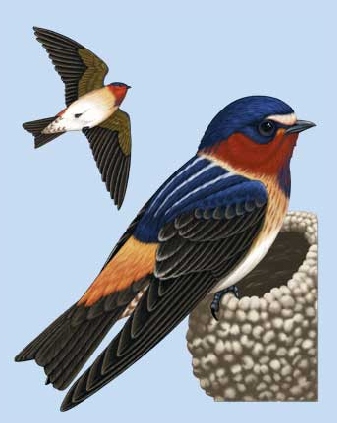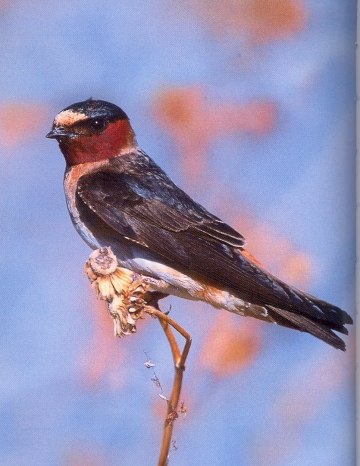|

Small, stocky swallow,
dark blue-gray upperparts, pale orange-brown rump, buff underparts.
Forehead is white or buff while throat, sides of face are orange-brown.
Crown is blue-black,
bill is short and black. Tail is dark and squared. Legs and feet are
gray.
Catches insects in flight.
|
CLIFF
SWALLOW
Petrochelidon pyrrhonota
PASSERIFORMES
Swallows (Hirundinidae)
Range
and Habitat
Cliff Swallow: Breeds from Alaska, Ontario, and Nova Scotia southward
throughout most of U.S. except the southeast; spends winters in the
tropics. Preferred habitats include open country near buildings or cliffs,
lakeshores, and marshes.
SOUND:
"churr", "zarp"
The Cliff
Swallow was first described in 1817
by Louis Jean Pierre Vieillot, a French ornithologist.
Females are known to lay eggs in its own nest and then carry one of
the eggs in its bill and put it in another female's nest.
When young leave their nests they congregate in large groups called
creches. A pair of swallows can find its own young
in the creche primarily by voice.

A group of swallows
has many collective nouns, including a "gulp", "herd",
"kettle", "richness", and "sord" of swallows.
The Cliff Swallow is a small bird largely found in North America and
Mexico. It will also rarely be found in western Europe.
Breeding and nesting grounds consist of large colonies, and females
will often transplant their own eggs to other mothers in the colony.
During winter months, the Cliff Swallow migrates to western South America
in the region of Argentina and Venezuela.
They prefer to nest in cliff areas, beneath overhangs,
and will often nest on man-made structures such as
dams and bridges. Their diet consists mainly of insects
which are caught during flight.
|